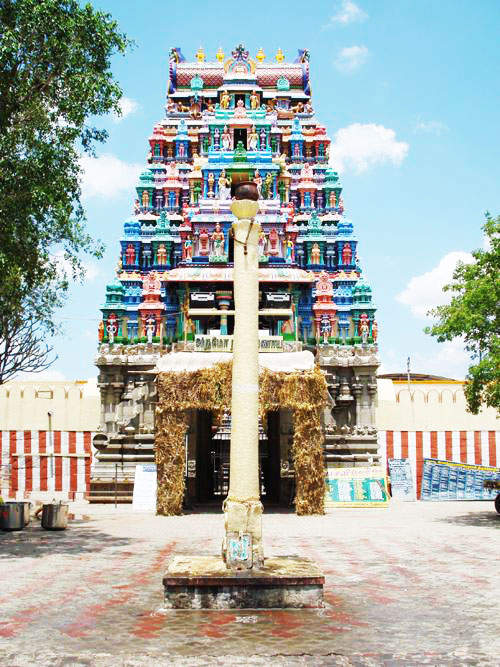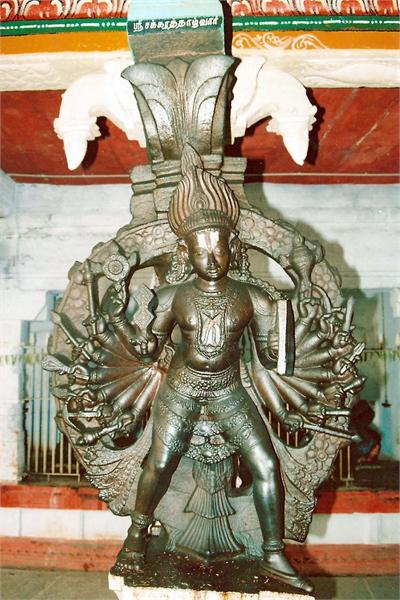28 December 2021, Plava varusha, Margazhi -13, Tuesday ;

Sri Soundararajaperumal Temple- ThadiKombu
Soundararajaperumal Temple, is unique of its kind dedicated to Vishnu, located in Thadikombu, a village near Dindigul in the South Indian state of Tamil Nadu. It has many special features as noteworthy. Constructed in Dravidian style of architecture, the temple is believed to have been built by Achyuta Deva Raya during the 16th century AD.Sri Soundarraja Perumal is found in the sleeping posture in this temple and it is said this place was previously known as Thaalamaapuri.
Main Deity Vishnu- worshiped as Sri Soundararaja Perumal
Thayar Lakshmi as Sri Soundaravalli.
Though it is a Vaishnava temple, the sthala vriksha is the vilva tree
The temple is known for the Ranga Mandapam, which features rare life size sculptures. The temple has two inscriptions dating back to Nayak period. The temple has a five-tiered Rajagopuram. The temple premises includes all the shrines and water bodies associated with it.

STHALAPURANAM:
SoundararajaPerumal is believed to have appeared for sage Mandukya (Mandukya means frog ). Once the sage was in the form of a frog in the place around the temple due to a curse. He was troubled by a demon and the frog worshipped Vishnu for rescue. Vishnu pleased by the devotion, saved the frog by killing the demon. This is a place where Lord Sri Vishnu saved “Mandooga Munivar” (Sage) from a Demon “Thaalasura” and helped him to continue his penance.
Perumal chose to stay at the place where he rescued the frog, where the temple is situated now.
The temple observes six daily rituals and three yearly festivals. The chariot festival, celebrated during the Tamil month of Chittirai (March–April), is the most prominent festival of the temple. The main festival of the temple is celebrated during the Tamil month of Chitrai, which falls in April and May. During this car festival, utsavam takes place for 12 days. During the Tamil month of Chithirai, utsavamurthy is taken in procession around the Mada veedhi of the temple. Similarly, purappadu takes place during the Tamil month of Aadi (July–August). The temple is maintained and administered by the Hindu Religious and Endowment Board of the Government of TamilNadu.

TEMPLE ARCHITECTURE:
Dindigul was the scene of warfare during the 15th century and people moved in large numbers to Thadikombu,. The temple is believed to have been built during the rule of Achyuta Deva Raya (1529–1542 CE), the younger brother of Krishna Deva Raya, during the 16th century. The construction supposedly began during the rule of his predecessor, Aliya Rama Raya (1485 – 1565 CE). There are inscriptions from various ruling empires on the contributions made to the maintenance of the temple. The outer halls and the sculptures were included during the period of Thirumalai Nayak (1623–59) in 1629. A damaged inscription in the temple from the period of Rama Raya is found in the Garuda Mandapa. An inscription in the Sundara Pandya Madap indicates the conduct of marriage festival of Kallazhagar in Madurai. Other inscription mention that the people of Madurai consider Thadikombu as their northern settlement. It is also learnt that a chieftain by name Sundaresan appointed the priests of the temple. It is also believed that a hall being named Sundarapandya, the temple might have existed from the earlier Pandyan era and might have been expanded by the Vijayanar kings.
The temple occupies an area of 1.5 acres (0.61 ha) and is surrounded by rectangular granite walls on all four sides, with a 90 ft (27 m) tall Rajagopuram (temple tower). All four sides around the temple are paved in such a way to accommodate movement of the temple car during festive occasions.

Festivals :
The temple follows vaikanasa aagamam. The temple priests perform the pooja (rituals) during festivals and on a daily basis. The temple rituals are performed four times a day: Kalasanthi at 8:00 a.m., Uchikalam at 12:00 p.m., Sayarakshai at 6:00 p.m., and Ardha Jamam at 10:00 p.m. Each ritual has three steps: alankaram (decoration), neivethanam and deepa aradanai for both Soundararajan and Soundaravalli. During the last step of worship, nagaswaram (pipe instrument) and tavil (percussion instrument) are played, religious Vedas are recited by priests, and worshippers prostrate themselves in front of the temple dwajasthambam. There are weekly, monthly and fortnightly rituals performed in the temple.

In the first praharam , Soundaravalli Thayar sannidhi, as well as shrines of Sri Andal and Sri Vishwaksenar is found. All the inner shrines face East, leaving the shrine of Viswaksenar, which faces South. The second praharam houses the shrine of Chakrathazwar. The vigraham of the Dasavatharam, the ten Avatars of Vishnu, are housed in the Anna Mandapam.

The presiding deity is housed in the Garbha graham in standing posture and has a height of 5 ft (1.5 m), with Bhoodevi and Sridevi on either side of Him, blesses the devotees. Utsavamurthy vigraham can also been seen inside the garbhagraham. The Kalyan Mandapam has musical pillars, each of which produce different musical sounds, which is similar to that of Madurai Meenakshi amman temple, Azhwar thirunagari temple, Krishnapuram Venkatachalapathy temple. The idol of standing Ganesha holding Angusa in his hands, Vishnu Durga containing exceptional features and Anjaneya occupying pillars are noteworthy. The fourteen life size images of the Sundarapandiya Mandapam are Vaikuntanathar, Sri Venugopalan, Sri Hayagreevar, Sri Saraswathi, Sri Namazhwar, Sri Dhanvanthiri Perumal, Sri Lakshmi Narasimhar, Mahavishnu, Chakrathazwar, Manmadan & Rathi, Trivikrama, Natarajar, Kali, Agora Veerabhadra, Ramar and Kartha Veerayarjuna.

The Ranga Mandapam, which is also called Anna Mandapam, has beautiful architectural representation of various forms of Vishnu, which is located near the Soundaravalli Thayar sannidhi. It is believed that similar architectural specimens of the Vijayanagar kingdom like Veerabhadra is found in Alagar koil, Srivilliputhur divyadesam, Adhikesavaperumal temple at thiruvattaru, Ramanathaswami temple at Rameshwaram.
SIGNIFICANCE ABOUT THE TEMPLE:
- All the above deities present in their respective shrines and shower their blessings to the devotees who pray in this temple. Some of the deities can be seen on the stone pillars as sculpture. People pray to these deities for their different wishes like education, timely marriage, Child Boon
- Sri Swarnagarshana Bhairavar is also present in a separate shrine in the North East area of this temple. Sri Swarnagarshana Bhairavar is also present in this Perumal temple which is an exceptional thing since Sri Bhairavar can be found in Sri Shiva temple only. Devotees pray Bhairavar here, to get rid of from loan related issues and legal related issues. The eigth day after the Full Moon day is called as “Thei Pirai Ashtami Thithi” which is considered as a auspicious day to Shri Bharava. On that day, special Poojas are being performed in this shrine in which many devotees participate.

- There are two Halls, named Anna Mandabam and Sundara Pandiya Mandabam in this temple. There are beautiful stone works can be seen in these halls.
- Sri Rathi and Sri Manmatha statues are present in the Sundara Pandiya Mandapam, which are so significant in this temple.
- This temple is known for the stunning stone works and deities Sculptures (“Sila Roopa”) are considered powerful to shower their blessings to the devotees.
- People pray at Sri Hayagrivaswamy and Sri Saraswathi shrine for the progress in education of their children. Special pooja is being performed in the evening time of “Thiruvonam” star days. Honey is being distributed as “Prasad” to the devotees. This is the only temple, where Sri Hayagrivar and Sri Saraswathi are found in the same place.
- People pray Sri Dhanvanthiri Perumal’s shrine to get rid of the health related issues. New Moon days are so significant and special pooja is being performed and the medicinal value Prasads are being distributed to the people who pray here, in the form of “Legiyam” and “Thailam”.
- People pray for Sri Andal shrine for timely marriage. On every Thursdays, special poojas are being performed in four schedules to get rid of marriage related issues. People continuously attend this pooja for five Thursdays. Once this pooja is over, garlands are offered to Sri Rathi and Sri Manmatha sculptures in the Sundara Pandiya Mandapam.
- Devotees pray for child boon at Sri Venugopalan shrine. They offer butter and jaggery to Sri Venugopalaswami at the time of their prayer. The “Rohini Star” days are considered as auspicious day for this pooja at Sri Venugopala Swamy shrine.
- The Pradhosham days, Full Moon days and the Swathi star days of the Tamil months are considered as significant days for Sri Lakshmi Narasimhar of this temple. People pray Sri Lakshmi Narasimhar on these days to overcome the issues related to loans, stress
- Sri Chakrathazhwar surrounded by the Devathas of Gayathri Manthra and Sri Narasimhar is surrounded by Ashta Lakshmi in this temple.

How to reach:
This temple is situated in Tamil Nadu Dindigul District., Thadikkombu Village.
- Thadikkombu village is located in the Dindukkal – Vedasanthoor route.
- The Thadikkombu village is around 10 Kilo Meters from Dindigul town.
- The nearest places around Thadikkombu village are Kodaikanal, Madurai, Pazhani and Sirumalai. .
- Nearest Railway Station is Dindigul Junction
- 18 KMs from Dindigul on Dindigul – Karur – Salem Highway
- Nearest Airport is Madurai Airport








